
Conceptual artist Elaine Reichek and recent winner of a Guggenheim fellowship talked Wednesday at the UArt Summer MFA “Food for Thought” series, and, Sonny, she gave the guys hell, using a gentle sense of humor.
(The “Food for Thought” schedule can be found here.)
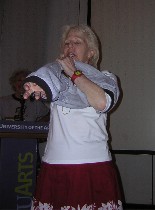
Before the talk began, however, she proved how game she was by donning a tee shirt designed by Gerard Brown who is in town for the summer as UArts Summer MFA faculty member.
How Reichek found her subject matter may have been her experience as an art student at Yale, a male enclave where she felt like the odd woman out. Some time during her Yale experience, she observed to herself, “These chairs were not designed with your behind in mind.” That was back around 1970.
The experience eventually transformed her thinking and her material. She switched from Minimalism to Conceptualism. And she changed from painting as her main material to embroidery, which, she said, had its own art history. It was a feminist act and it was subversive. The change was gradual, but ultimately dramatic, given that at Yale Ad Reinhart was her mentor.
madamimadam
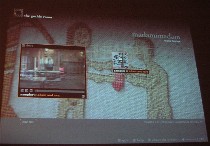
A recent project of hers, “madamimadam,” at the Isabella Stewart Gardner Museum in Boston, involved placing her series of samplers all related to the Adam and Eve story in the museum on closed days, taking pictures, and then creating an interactive CD-ROM (right, “Adam and Eve,” images based on a number of early-American samplers, from “madamimadam”).This was the only way to get her work in the Gardner, which has a rule against changing the exhibit.
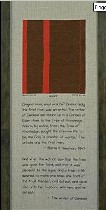
The CD-ROM, however, has her interventions in place, hanging among the old (boy) masters. The interactive CD is online here. Fiddle around with it for a minute or two and you’ll get the idea. It’s got sound and details. You can listen to a quote from Barnett Newman in which he uses the Adam and Eve story to prove that a man was the first artist, and you can see an image of Reichek’s embroidered version of a Newman (left, “Original Man,” Reichek’s Newman appropriation with quotes from Newman and Genesis). You can hear a quote about a sci-fi Creation from Stanislas Lem.
The mighty computer
With needle and thread, Reichek has been stitching her way through history and art history. The computer she credits with helping her find quotations–about communication, translation, men and women, etc.–that she then pairs with imagery.
She loves the way the Internet and the computer can come up with connections and samples that more conventional searches would not find. It’s the new thinking, as far as Reichek is concerned. (And we who are of a certain age are certainly grateful for how it has expanded our memories.)
Words and images
It’s the juxtapositions of the imagery with the words and the material that point up the questionable underlying assumptions in the imagery and in the words. “It’s in the interstices between the appropriation of an image and an appropriation of a text that the meaning is. They come from different times and different media. Web knowledge and the way knowledge comes up these days is a whole new way of thinking. Every medium carries its own meaning.”
Her love of the computer and what it can do has now brought her to another tool. She mentioned she just bought a digitized home sewing machine and is struggling up a mountainous learning curve. “My studio looks like a sweatshop,” she said. “I have so many machines, I’ve started giving them names.”
Language and translation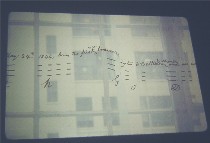
She has stitched her way through macho-centric quotes from Samuel Morse (who painted as well as invented) to the Bible to filmmaker David Cronenberg. She has also stitched her way through symbols of language and communication, which is the underlying theme in all of her work (right, Reichek’s sheer curtain with Morse’s first telegraphed message in both the original Morse Code and our alphabet).
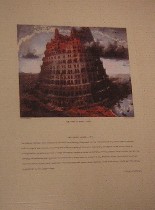
She has paired Bruegel’s “Tower of Babel” translated into stitchery with a quote from Jorge Luis Borges. Babel is a favorite choice for her because the story is about language and the ability to communicate, she said. She thinks of her embroidered borrowed images as translations. And speaking of translations, she has found, when paying careful attention to the words males use, that men are Neanderthals from Mars, and therein lies the gender gap (left, Bruegel’s “Tower of Babel” as stitched by Reichek).
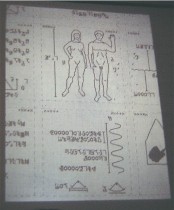
She has translated Macintosh screen savers into embroidery as well as the message that the world’s largest radio telescope transmitted into space just in case there’s life out there. She takes note of the woman’s stereotyped, sexy pose, the pairing of the man and woman like Adam and Eve, the numerous codes the scientists hoped aliens could decipher, and she especially loves the part of the messages that states, “No message could ever be free of ambiguity.” Then she notes, “These folks are funded by the government, incidentally” (right, detail of embroidered version of message sent to space by the world’s largest radio telescope).
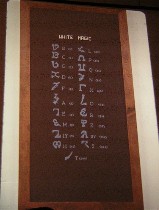
She worries that the Library of Congress has been digitizing its contents, but that by time they are done recording it all, the technology will have moved on. “It will be passe and unreadable,” she said. Some of it already is, she said (left, “White Magic,” an alphabet used the practice of white magic).
Often, when appropriating a painting or other imagery, she uses a computer to break the image down into pixels, each pixel a stitch, a single color. Sometimes she does the translation by hand.
Appropriation of a different kind
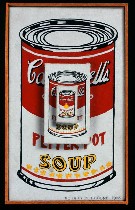
Reichek explained in response to a question from Rosenwald-Wolf Gallery Director Sid Sachs that her own work is different from that of other appropriation artists like Richard Pettibone, Elaine Sturtevant and Sherrie Levine. Reichek said the others were about ownership, capitalism and duplication, and not about feminism or history. “My work has to do with philosophy.” And Reichek’s sources are more wide-ranging than just art–they are cinematic and post-modern, she said (right, Pettibone’s “Andy Warhol, ‘Campbell’s Soup Can [Pepper Pot]” oil on three attached canvases, 10 3/8 x 6 3/8 inches).
Which brought Reichek back to her choice of embroidery. She said she admired it for its conflation of high and low culture.
“Who writes the history gets the memory,” she observed. And by putting historic memory into a computer, that history gets rewritten. And she thinks the computer searches, with their algorithms and surprising finds, are doing the rewriting. And then she’s translating it into embroidery to write her found version into art history.
About teaching
Of her teacher Reinhart at Yale, Reichek said she learned “scrupulosity” from him–that every thing you put on the canvas matters. “If a teacher teaches you anything, it’s about how to think,” she said. But she also observed that his practice of picking favorite students was not good teaching. “If you were struggling with something he wasn’t interested in, he didn’t have time for you.”









